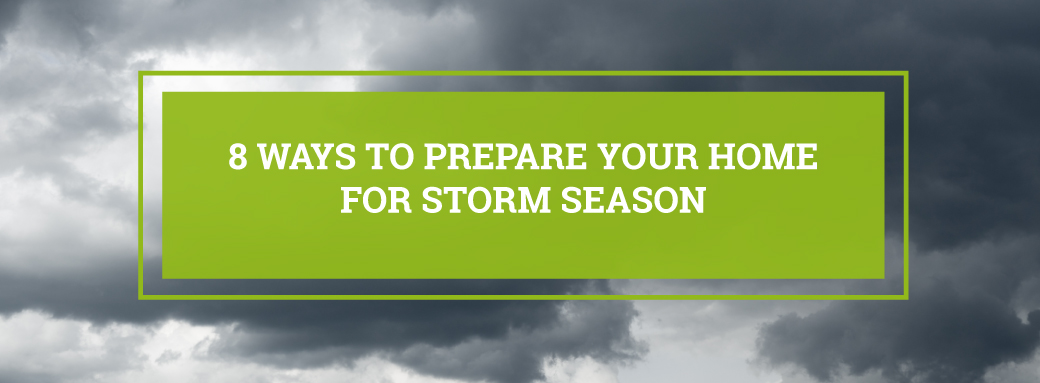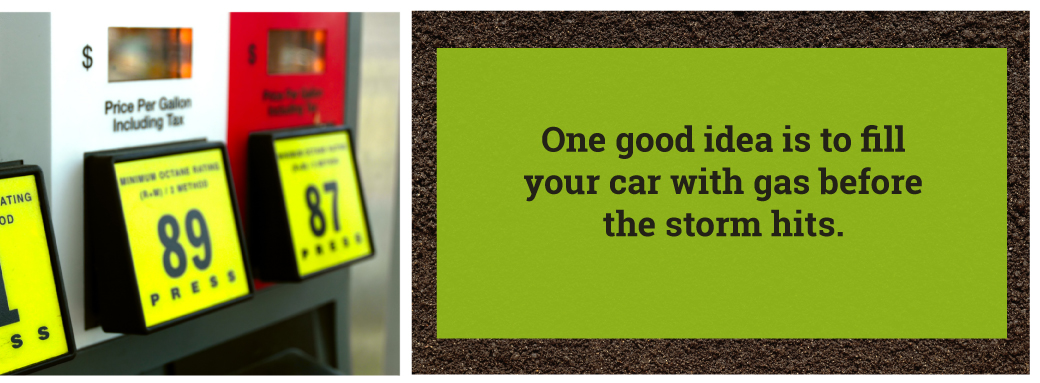

When storm season starts brewing, the most important thing to worry about is how your home is prepared to weather the storm. Depending on the type of house you live in, your concerns might be slightly different than those of your neighbors.
Regardless of what type of house you have, how many cars you own, how many trees are in your yard or any number of other concerns, however, there's one thing you and all your neighbors will have in common. It's the need to get your house and family ready to withstand any severe weather the season might produce.
Some simple disaster preparedness can go a long way toward helping you weather the strong winds and rains of storm season. To help get you, your house and your property ready, we’ve compiled a guide with some of our most helpful tips for making it through this tough season. Implement these, and feel confident that even if a severe storm hits, you’ll be ready for it.
1. People Before Property
When it comes to protecting the things you love from a severe weather event, realize that nothing is more important or valuable than people. It doesn’t matter how much money or how many valuables you have in your house. The number one rule in any emergency is that people come first.
To prepare your family for severe weather, take some time to sit down with everyone and formulate an evacuation plan. Find out where your nearest evacuation center is, and make sure everyone knows how to get there. Practice driving multiple routes to this center during good weather. This way, if an emergency ever does happen, everyone knows how to get to safety.
If local authorities advise that there is a storm on the horizon, take a minute to refresh everyone as to your emergency plans. Encourage your family to stay together and safe until the storm scare has passed.
Go over other rules of disaster storm preparedness with your family. Explain that cell phone batteries should be saved and used only for emergencies. Talk about doing head counts and sticking together. Go over some basic principles of first aid. Anything you can think of that might help keep the people you love safe in an emergency is a good idea. It’s always better to be over-prepared than not prepared enough.
2. General Emergency Preparedness
If there are signs of a storm on the horizon, you can take plenty of steps to get yourself and your family ready.
One good idea is to fill your car with gas before the storm hits. If you need to pile your family and belongings into the car at a moment’s notice, you'll want to have confidence that it can carry you to safety and won’t run out of gas halfway to your evacuation.

It’s also an excellent idea to stock up on food and water. Before a storm hits, your home should have enough supplies for every person to last at least three days in case flooding from the storm prevents you from reaching the grocery store. Other items to make sure you have on hand include any necessary medications, blankets, first aid kits and flashlights with spare batteries. If you get in your car to evacuate, make sure to grab these important items to bring with you.
Don't wait until the last minute to stock up on these items, either. If you wait until the day before the storm is due to hit, you may find yourself waiting in long lines at the store, only to find that the items you need have sold out. Prepare early instead.
3. Secure Important Paperwork and Documentation
We may take it for granted that official documents like social security cards, birth certificates, property deeds, insurance cards and the like are always safe in our homes. But when disaster strikes, this security may not be the case. When storm season rolls around, it’s crucial to keep vital documents like this safe and dry.
One possible way to keep these documents safe is to simply relocate them. You might place them in a secure holding at a bank. If you see a storm coming, you might also ask a relative who lives in a more protected area to keep them safe for you.
It’s an excellent idea to make copies of these documents as well. If and when the time comes to evacuate your home and head for safety, carry them with you in a waterproof case or container. It might not seem important at the time, but you’ll be glad you did. If the storm truly does devastate your home, you'll be grateful for a way to prove that it was your house and that you have the insurance to back it up.
4. Repair and Reinforce
The main idea here is that you want everything on the exterior of your house nailed down, tied down or brought inside. Anything left loose — or even halfway loose — will become a hazard during a storm. Your goal is to firmly secure these items so that they aren’t able to blow around or be pulled apart.
Your roof is one particular area that deserves your attention. Give it a once-over to make sure it’s in good condition. If there’s any room for doubt, get it fixed before storm season arrives. Make sure everything is properly installed and not worn out or in need of replacing.
If there's anything loose on the outside of your house, secure it. The issue might be a loose shutter, loose shingles or anything else. Either remove it or find a way to secure it tightly. It’s also important to move any patio furniture indoors. If furniture is left outdoors during a storm, it could blow into your house, car or even another person and cause serious injury.
5. Assess and Trim Your Trees
If you’ve been through severe weather and an ensuing disaster recovery plan, you know that fallen and damaged trees are no laughing matter. The raging winds and driving rains that come with hurricanes and other intense weather patterns can rip even healthy trees out of the ground, and they cause particularly fierce devastation when it comes to dead or dying trees.

The good news, however, is that there's plenty you can do before the storms hit to reduce your potential tree damage. Your first step should be to assess the trees on your property. Are any of them dead, old or sickly looking? Are there loose branches that look as though they could be knocked down by a strong gust of wind? If the answer to any of these questions is “yes," you have your work cut out for you. These issues are hazardous when a large storm blows through. To combat the problem, call a local tree removal and pruning service.
If a tree is entirely dead or looks as though it will be soon, it should be removed. It will certainly become a hazard during a heavy storm, but it may even cause problems before then. Storm season or not, these types of trees should be removed for everyone’s safety. If you live in Northern Virginia, DC or Maryland, contact us at Richard’s Tree Service. We'd be glad to help with tree removal for any problem trees on your property.
Sometimes, the entire tree doesn’t need to be removed. Maybe it’s just one limb that’s a problem. Or maybe you’re simply worried about how big a tree has gotten. If you’re just looking for some tree pruning, we can help with that too. We have years of experience with tree trimming and are always ready to help as you look for ways to prepare for severe weather.
If, after the storm has come and gone, you find that trees in your yard have been downed, we can assist you with the problem. We regularly perform tree stump removals and would be glad to help you clear your property of tree debris. No matter what you need help with, your local certified arborists at Richard’s Tree Service are ready to perform any type of emergency tree service you might need. We even perform tree assessments to help you determine which kind of your trees might become a problem during a severe storm.
6. Know How to Shut off Your Home’s Utilities
Electricity and water don’t mix. You don’t want to have an electrical fire on your hands if your wiring becomes damaged in a storm. And if a heavy storm comes along, the last thing you want is even more water to deal with if a pipe bursts.
For reasons like these, it’s important to know how to shut off your home’s utilities should the need arise. This process isn’t something you need to do every time the skies get dark and some rain starts to fall. But if it looks like a truly dangerous storm is about to hit, take the extra precaution of switching your electricity and water off. It’s always better to be safe than sorry.

Of course, to do this, you’ll need to know ahead of time how to turn your utilities off. If you don’t already know this information off the top of your head, now’s the time to find it. Locate your home’s water shut-off valve, and know how to use it. Locate your circuit breaker panel — often found in a garage, basement or laundry room — and review how to flip the switches to cut the power to your home.
Hopefully, you’ll never need to use these measures. However, if you do, it’s always best to be prepared.
7. Prepare Your Windows
You’ll want to pay extra-close attention to your windows as you prepare your home to weather the storm. Because they’re glass, they’re susceptible to breaking, especially if heavy debris gets flung against them by the wind. This issue would result in not only broken glass flying everywhere but also your house no longer being weather-tight.
One of the best ways to weather-proof your windows is to install storm windows. You might also install hurricane shutters and secure them into place over the windows. If you’re not sure how, don’t hesitate to contact a professional. It’s important to get the job done right, and if you don’t feel confident, a professional will be able to complete the task easily enough.
Another way to keep your windows safe is to buy plywood sheets and hammer them into place over the windows, which will help keep the glass intact and protect it from any flying debris that would otherwise harm it.
If these aren't good options or you’re dealing with windows that are at slightly lower risk, you can use duct tape or another heavy-duty tape to create an X-shape over the windows. This precaution will protect against shattering and help keep the windows in one piece during the storm.
8. Plan Ahead
It can be difficult to contemplate the potential fallout of a catastrophic storm. No one wants to think about what might happen, which is perfectly natural. However, to give yourself, your family and your home the best chance of making it to the other side unscathed, it’s important to spend some time coming up with plans.
One of the plans you’ll need to make involves deciding what contractors you might need to get in touch with after the storm. Make a list of everything you can think of that might need work after the storm, and come up with a list of contractors who will be able to help.
Another thing to plan is a list of people to call after the storm has passed — people who will want to know if you’re all right and those you want to check on. This list doesn’t have to include everyone you’ve ever met, but it should consist of people who will be worried about you and glad to hear you’re safe. It should also include anyone who lives near you and might also be in danger. It will be a huge weight off your mind to know they’re safe as well.
Preparedness Is Key to Making It Through Storm Season
The prospect of facing storm season might be intimidating, and for good reason. We can’t predict every emergency, and we can’t prevent every disaster. However, peace of mind comes from being prepared and knowing that if disaster does strike, you have plans, and you know what to do. Being able to take control of a situation gives you the confidence to live your life without the constant fear of what might happen.

If you’re looking for ways to weather-proof your home in preparation for storm season, we hope these tips are helpful to you. And if you’re looking to have any of the trees on your property pruned, removed or serviced in any other way, don’t hesitate to contact your local licensed arborists here at Richard’s Tree Service. Fill out our contact form to request a quote from us today.
If it is an emergency please call us immediately at 703-354-3667.
Use this form to schedule a FREE estimate. After submitting your form, our team will contact you to set up this appointment.
